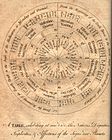Ebenezer Sibly
Ebenezer Sibly (1751 – c. 1799) was an English physician,

Life
He was the son of Edmund Sibly and Mary Larkholm, born in the parish of Cripplegate ward, London.[1] He was the brother of Manoah Sibly. Early on he devoted himself to medicine and astrology. He studied surgery in London.[2]
In 1785 he was working as an astrologer in Bristol; and by about 1788 had moved to London. In 1789 he became the first master of the Lodge of Joppa #188, one of the founding masonic lodges under the
As a student of medicine, he became interested in the theories on
Sibly died in London around 1799.[3]
Works
Sibly is celebrated for the natal horoscope he cast of the United States of America, published in 1787 and is still cited.
Translations
Ebenezer Sibly used an eclectic mixture of
The Complete Illustration
Sibly published the New and Complete Illustration of the Celestial Science of Astrology in four volumes, from 1784.

Other works
Sibly published A Key to Physic, and the Occult Sciences, in 1792.[10]
Sibly wrote a book called Universal System of Natural History in 1794. In the book, in a form of
“We must consider white as the stock whence all others have sprung, Adam and Eve and all their posterity, till the time of the deluge were white; in the first age of the world no black nation was to be found on the face of the earth.”
Sibly believed that humans had not reached Africa until after the dispersal from the Tower of Babel, that the continent's first inhabitants had been white, and that Africans had become dark only as a result of climate.[13]
The original version of Culpeper's English Physician and Complete Herbal was published in 1652 without illustrations. In 1790 an illustrated version of the book was produced with drawings done by Sibly.[14]
-
A table showing the zodiacal signs and their gender, triplicities, and quadruplicities, and essential dignities; houses and their gender and locational status.
-
Horoscope drawn for the birth of Martin Luther.
-
A heliocentric universe showing the planets' correct distances and the zodiacal signs with Aries beginning at the horizon and the other signs following in correct order.
-
Horoscope drawn for the speculated birth time of Jesus Christ, midnight, 25 December, in the Julian year 45.
Notes
- ISBN 9780190687328.
- ^ a b . Dictionary of National Biography. London: Smith, Elder & Co. 1885–1900.
- ^ doi:10.1093/ref:odnb/25502.required.)
{{cite encyclopedia}}: Missing or empty|title=(help) (Subscription or UK public library membership - ^ Debus p. 261
- ^ . Dictionary of National Biography. London: Smith, Elder & Co. 1885–1900.
- ^ . Dictionary of National Biography. London: Smith, Elder & Co. 1885–1900.
- ^ Debus p. 263.
- ^ Joscelyn Godwin, The Theosophical Enlightenment (1994), p. 107; Google Books.
- ^ Martha Keith Schuchard, Why Mrs. Blake Cried (2006), p. 272.
- ^ Wouter J. Hanegraaff, Esotericism and the Academy: Rejected Knowledge in Western Culture (2012), p. 237; Google Books.
- ^ Volume 4 is available online.
- ^ Owen Davies, Grimoires: A History of Magic Books (2009), p. 134.
- ^ Colin Kidd, The Forging of Races: race and scripture in the Protestant Atlantic world, 1600 - 2000 2006, p. 30; Google Books.
- ^ "Culpeper s English Physician; and Complete Herbal. To which Are Now First Added Upwards of One Hundred additional Herbs, with a Display of Their Medicinal and Occult Properties. By Culpeper, Nicholas (1616- 1654) and Ebenezer Sibly.: Very Good Hardcover | Trillium Antiquarian Books".
External links
- Allen G. Debus, Scientific truth and occult tradition: the medical world of Ebenezer Sibly (1751-1799), Medical History 1982 July; 26(3): 259–278. (online text as PDF)
- Attribution
![]() This article incorporates text from a publication now in the public domain: "Sibly, Ebenezer". Dictionary of National Biography. London: Smith, Elder & Co. 1885–1900.
This article incorporates text from a publication now in the public domain: "Sibly, Ebenezer". Dictionary of National Biography. London: Smith, Elder & Co. 1885–1900.




